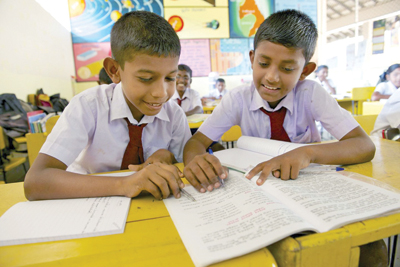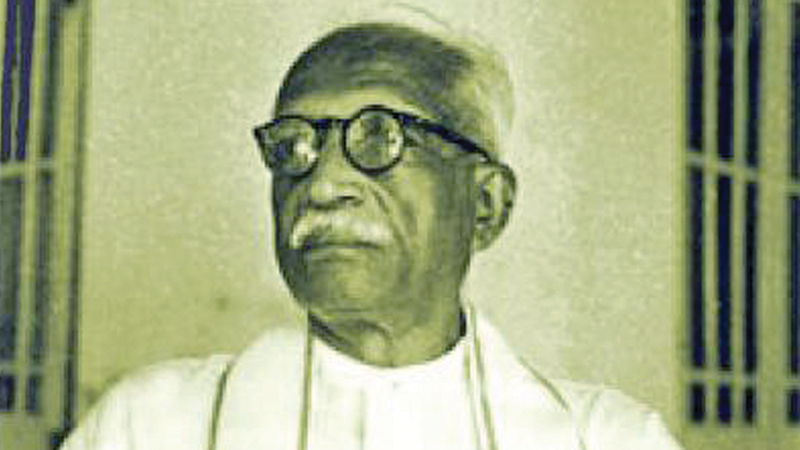The system of education in British-ruled Ceylon went through several phases till the State Council of the Crown Colony adopted what came to be known as the “Kannangara reforms” in 1945, in the twilight years of British rule.
In theory, the system devised by Dr. C.W.W.Kannangara still exists, but in a warped form, thanks to manipulations by successive social and political elites driven by exigencies of the moment rather than deep thought, says Colombo University’s Dr.Panduka Karunanayake in his seminal work Ruptures in Sri Lanka’s Education.
In the popular imagination, the Kannangara model is synonymous with the “free education system” that Sri Lanka prides on. The system envisaged free, State-funded education from the primary to the university level to all students, irrespective of their gender or social status. Universal and free education was thought to be a necessary follow-up to the grant of Universal Adult Franchise to the Ceylonese in 1931, a pioneering step in this region and the world.
However, it was not until 1939 that the State Council set up a committee under Dr. Christopher William Wijekoon Kannangara, a lawyer who became Minister of Education in 1931. Better known as Dr. Kannangara, he devised an educational system for the masses as well as the social elite in 1942. It was formally adopted in 1945.
Under the Kannangara system, vernacular (Swabhasha) education was given to all children at the primary level. For the secondary level, “clever” students were selected for admission to the Central Colleges (Madhya Maha Vidyalayas) for an English medium education. The change in the medium was to enable the vernacular educated children to enter the State universities where the medium of instruction was English.
Best model
Education at the Central Colleges was such that their students could compete with students from the elite schools in cities like Colombo. Science was taught so that students could go for medicine or engineering where, again, instruction was in English. Between 1943 and 1945 Dr. Kannangara himself established 54 Madhya Maha Vidyalayas.
 Dr. Karunanayake says that it is important to note that the Kannangara model did not destroy the past but supplemented and built on it. In other words, fee-levying schools catering to the English-speaking elite remained but were supplemented by the Central Colleges catering to a different class of people, rural and non-English speaking. The latter were trained to compete for university admission on an equal footing.
Dr. Karunanayake says that it is important to note that the Kannangara model did not destroy the past but supplemented and built on it. In other words, fee-levying schools catering to the English-speaking elite remained but were supplemented by the Central Colleges catering to a different class of people, rural and non-English speaking. The latter were trained to compete for university admission on an equal footing.
Dr. Karunanayake says that it would be wrong to blame the Kannangara model for the fall in the standard of English in Sri Lanka. His system did not ban English medium education, just as it did not ban fee-levying schools. Under his system, both coexisted harmoniously, giving the best to the students of all classes and getting the best out of students of all classes.
Yes, the Kannangara system did not assure high-class education or university education to everyone. There was some filtering. Only the “clever” ones were admitted even to the Central Colleges. This was the reason why the education system of Ceylon was well-regarded internationally in the first two decades since Independence.
But Ceylon’s social elite then entrenched in the State Council conspired to weaken the Central Colleges by postponing the teaching of English and cutting off funds for the Science courses that adversely affected laboratory facilities, Dr. Karunanayake says.
With the result, students from the Central Colleges faced difficulties in entering the science and medical courses because entrance tests included practicals and laboratory skills.
Since the Central College students were also poor in English they could not make it to the University of Ceylon. To give them a university education, the Government converted the Vidyodaya and Vidyalankara Pirivenas (Buddhist seminaries) into Sinhala medium universities.
The English-speaking elite were thus instrumental in reviving the old divide between them and the Sinhala-educated. The Kannangara system had received the first blow.
Given the obstacles created by the social elite-dominated University of Ceylon, post-1956 populist Governments abolished university autonomy. The university lost the right to determine the medium of instruction and even the student intake. Government servants were appointed as Vice Chancellors and Registrars.
By the end of the 1950s Buddhist nationalism had become a major force. In 1960, the Government was forced to take over the denominational schools run by Christian missions and also bring about uniform curricula.
Populism led to university admissions increasing by leaps and bounds, even as Ceylon’s economy deteriorated creating unemployment. The insurgency led by educated youth in 1971 was an inevitable consequence. However, the churning in the university only led to a loss of university autonomy. By an Act of 1972, the various universities (Colombo, Peradeniya, Vidyodaya and Vidyalankara) were made campuses of a single “University of Sri Lanka”.
Liberalisation process
However, in 1978, perhaps on account of the liberalisation process initiated by President J.R. Jayewardene, university autonomy was restored. The campuses in Colombo, Peradeniya, Vidyodaya and Vidyalankara were again made separate universities, though the medium of instruction and student intake remained the preserve of the Government under the University Grants Commission (UGC), the same model used in India and several other countries.
Given the economic downturn due to the ethnic conflict, State-funding was becoming scarce. Schools were increasingly maintained by the philanthropy of their past pupils. But this created the “past-pupils quota” in Grade One admissions, that, in turn, led to the “reproduction of existing inequalities” as Dr. Karunanayke put it.
The gap between urban and rural schools widened and corruption thrived. Grade One admissions became a scandal. According to Dr. Karunanayake, the education sector contributed the single largest number of complaints to the Bribery Commission.
With the formal education system getting atrophied, private tuition classes mushroomed becoming a roaring business. Private post-secondary education outside the university system was made possible when the Government allowed the setting up of private institutions to teach courses in commerce, finance, accounting, IT and so on in collaboration with the private sector and professional institutions like ICA, CIMA and AAT.
With the deterioration of the university system due to a lack of well-thought-out policies, poor funding and increased admissions, many youth from well-heeled families took admission in overseas universities, leading to a drain of already scarce foreign exchange. Poor teaching in the schools and universities led to the proliferation of expensive tuition classes.
Although the Left and student unions riled against “privatisation”, the privatisation of education was in full bloom in their very midst. Their opposition to privatisation was purely ideological and political and not rational and realistic, Dr. Karunanayake said.
Better communication skills
Private initiatives in education were welcomed by the people as well as the private sector as they gave students useful skills that the university education did not. Students from these private institutions also acquired better communication skills in the English language which were required in the private sector for public relations, sales and marketing. But these private sector education/training institutions were unregulated. There is still no State oversight.
At the school level, there was a mushrooming of “International Schools” which prepared students for local as well as London A/Levels. But there was no State supervision or regulation of these institutions.
Dr. Kannangara envisaged an all-Island system of education where primary education would be available to all, Secondary education to select clever ones, and a University education for a smaller number comprising top talent. It envisaged private as well as public investment. English and the vernacular languages coexisted as media of instruction, each with an assigned place in the system. Adequate scope for education in the arts as well as the sciences and the provision of adequate funds was envisaged. Fee-levying as well free-education coexisted in a way that the State and the taxpayer were not unduly burdened.
But the State of education in Sri Lanka is far from Dr. Kannangara’s scheme. Free education is used as a weapon to stall educational progress in a financially sound way. Expansion of higher education through private initiatives is blocked even as the well-to-do are allowed to drain scarce foreign exchange for a foreign degree. Swabhasha education is the creed even as expensive English language tuition classes thrive in the unorganised private domain.
The social class divide has been widened with economic deterioration limiting available opportunities to a minority of well-heeled Sri Lankans. These inequalities must be rectified to widen the scope of free education as envisaged by Dr. Kannangara, whose 54th death anniversary fell on September 23.




